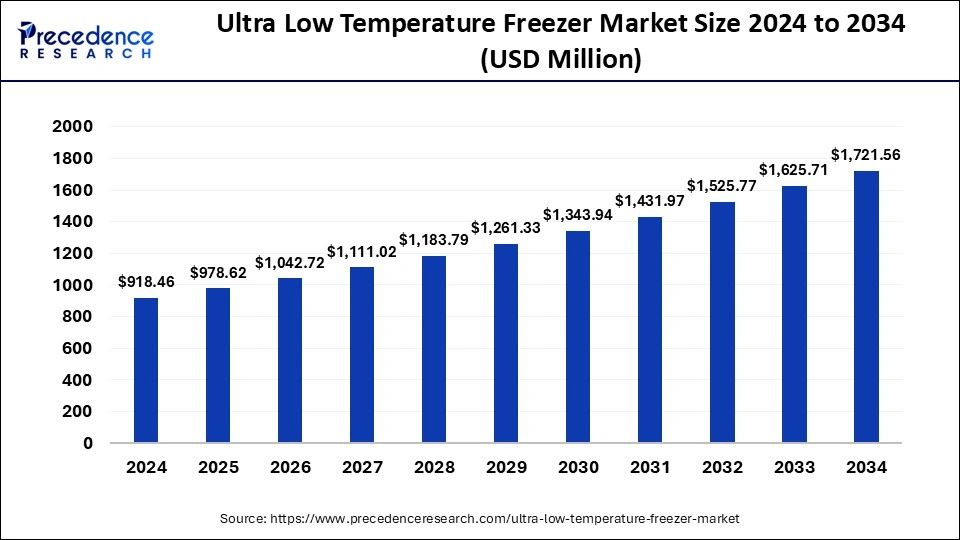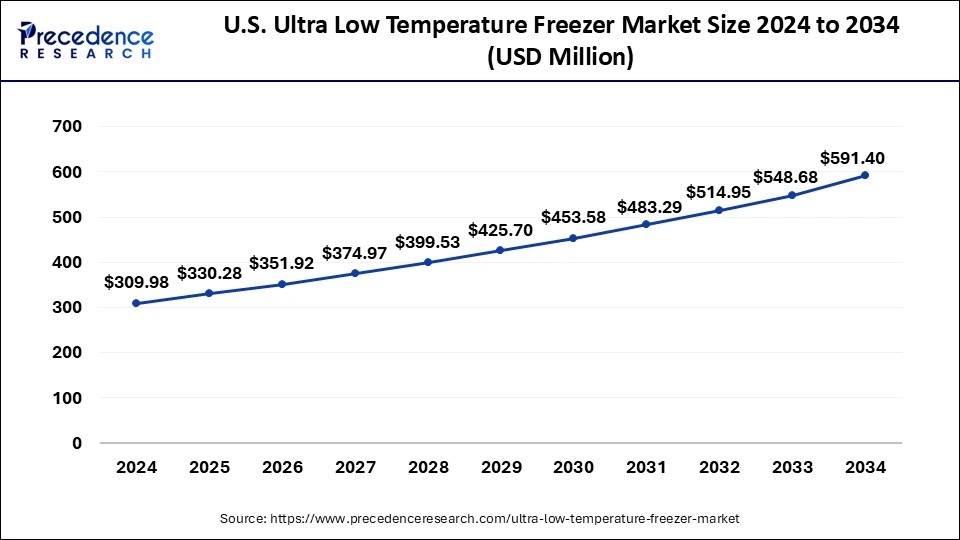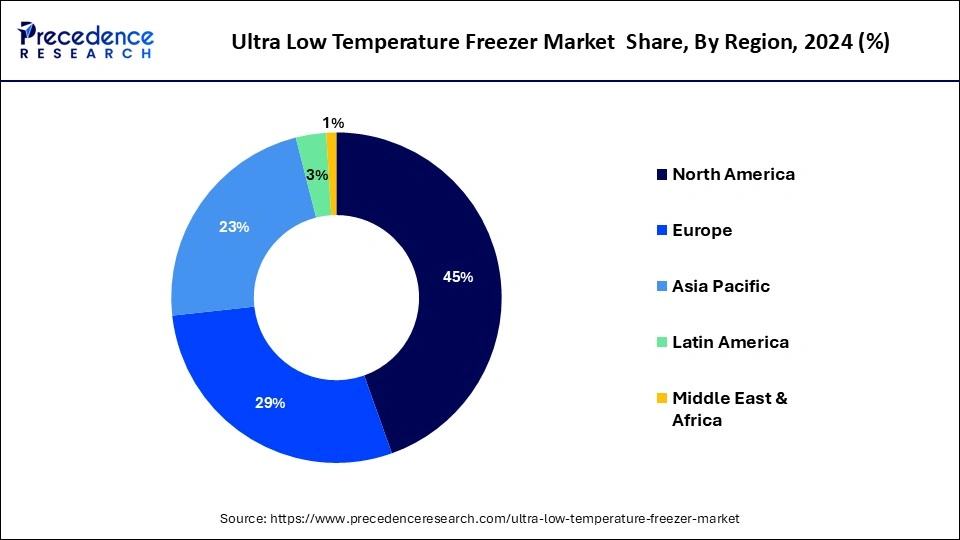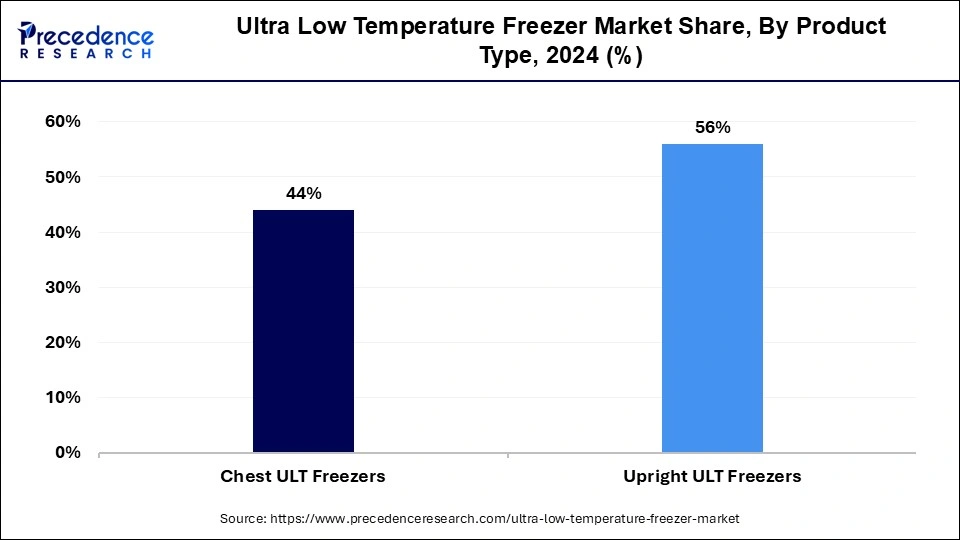List of Contents
Ultra Low Temperature Freezer Market Size and Forecast 2025 to 2034
The global ultra low temperature freezer market size accounted for USD 918.46 million in 2024 and is predicted to increase from USD 978.62 million in 2025 to approximately USD 1,721.56 million by 2034, expanding at a CAGR of 6.48% from 2025 to 2034.

Ultra Low Temperature Freezer Market Key Takeaways
- In terms of revenue, the global ultra low temperature freezer market was valued at USD 918.46 million in 2024.
- It is projected to reach USD 1,721.56 million by 2034.
- The market is expected to grow at a CAGR of v% from 2025 to 2034.
- North America dominated the ultra low temperature freezer market with the largest market share of 45% in 2024.
- Asia-Pacific is estimated to expand at the fastest CAGR between 2025 and 2034.
- By product type, the upright ULT freezers segment has held the largest market share of 56% in 2024.
- By product type, the chest ULT freezers segment is anticipated to grow at a remarkable CAGR between 2025 and 2034.
- By end-user, the academic and research laboratories segment generated a major market share in 2024.
- By end-user, the bio-banks segment is expected to expand at the fastest CAGR over the projected period.
U.S.Ultra Low Temperature Freezer Market Size and Growth 2025 to 2034
The U.S. ultra low temperature freezer market size was exhibited at USD 309.98 million in 2024 and is projected to be worth around USD 591.40 million by 2034, growing at a CAGR of 6.69% from 2025 to 2034.

North America held the largest share of 45% in 2024, the ultra low temperature freezer market due to advanced healthcare infrastructure, robust research and development activities, and a high prevalence of biopharmaceutical companies. The region's strong focus on biopharmaceutical research, especially in the United States and Canada, drives the demand for ultra low temperature Freezers. Additionally, the presence of key market players, strategic investments in healthcare, and a proactive approach to adopting innovative technologies contribute to North America's dominance in this market.

Asia-Pacific is poised for rapid growth in the ultra low temperature freezer market due to expanding healthcare infrastructure, rising biopharmaceutical research, and increasing awareness of the importance of precise sample storage. The region's growing investment in research and development, coupled with rising demand for vaccines and biologics, fuels the need for advanced cold storage solutions. Additionally, the escalating prevalence of chronic diseases and infectious outbreaks further amplifies the demand for Ultra Low Temperature Freezers in the Asia-Pacific region, making it a key area for market expansion.
Meanwhile, Europe is experiencing notable growth in the ultra low temperature freezer market due to several factors. The region's increasing focus on advanced medical research, particularly in vaccine development and personalized medicine, has led to a rising demand for these freezers. Additionally, stringent regulations regarding the storage and transportation of biological materials have propelled the adoption of Ultra Low Temperature Freezers. The region's commitment to healthcare infrastructure development, coupled with the ongoing COVID-19 vaccination efforts, has further intensified the need for reliable storage solutions, contributing to the market's significant growth in Europe.
North America
North America is the largest market for ultra-low temperature freezers worldwide, based on the size and growth potential of its life sciences ecosystem, as well as robust biopharmaceutical and research infrastructure. North America contains large and diverse concentrations of institutions like clinical laboratories and biotechnology businesses, along with biotechnology facilities that need specialized cold storage, such as ultra-low freezers for the storage of vaccines, biological samples, and other drug components.
Furthermore, the development of academic and commercial biomedical research, supported by government funding and investment in precision medicine, further influence the demand for effective and energy-efficient ULT freezers. Ultra-low temperature freezers are more frequently prioritized in the U.S. and Canadian lab market than any other country in the world, and often equipped with IoT monitoring and predictive maintenance.
As laboratories also adopt stricter regulatory standards, such as sustainability, North American laboratories are more likely to buy environmentally friendly models, which will continuously position North America as the most advanced market, by growth rate and volume, by a wide margin.
Asia-Pacific
Asia-Pacific is becoming the fastest developing region in the ultra-low temperature freezer market due to its accelerated growth in healthcare infrastructure, pharmaceuticals, and biotech manufacturing. Ultra-low temperature storage is needed for the notable increase in clinical trials, production of vaccines, and genomic studies in developing countries like India and China or with strong investments in biotech like Japan and South Korea. Government investments in life sciences are on the rise with the demand for biobanking increasing.
Awareness campaigns on preserving samples with proper storage are also leading to a higher adoption of ultra-low temperature freezers especially with academic institutions and research labs. With companies like Roche moving to Asia-Pacific, contract research organizations (CROs) making their mark and increasing demand for high capacity, profitable product, ultra-low temperature freezers with appropriate monitoring and alarms is on the rise with new companies, private research institutions and other regulatory drivers.
Europe
Europe represents a substantial portion of the ultra-low temperature freezer market, as a result of the region's highly developed biomedical research capabilities, advanced pharmaceutical industry, and proactive sustainable regulations. The ULT freezer market is chiefly driven by the ULT-savings from advancements in genomics, personalized medicine, and biotechnology, with Germany, the UK, France and the Netherlands leading the region in research and development of these fields which rely on reliable ultra-low temperature storage systems.
The regional trend towards green laboratories and energy-efficient technologies has led to the adoption of environmentally friendly ultra-low temperature freezers with low global warming potential refrigerants. Further, while internationally applicable EU standards related to biological sample handling and cold chain logistics are part of the challenge, they also provide a driver for laboratories to invest into high performance and smarter freezers that possess monitoring capabilities assisted with cloud-storage technology and complying tracking capabilities.
Role of AI in Ultra Low Temperature Freezer Market:
The ultra-low temperature freezer market gaining attention due to artificial intelligence's revolutionizing capacity to improve accuracy, efficiency, and predictive reliability. AI has given ultra-low temperature freezers the ability to continuously monitor performance in real-time including various temperature changes, energy usage and operational anomalies. With the advent of AI technology, the storage of critical biological samples are better able to remain at safe temperatures.
AI is able to identify performance issues, inconsistencies that would reduce freezer performance including lab practices, as well as predicting failure before the failure occurs. The main uses of AI in ultra-low temperature freezers would be prepare a lab for a minimum of downtime, increasing the overall lifespan of ultra-low temperature freezers, and minimizing total loss of samples.
Secondly, in both the pharmaceutical and biotechnology markets the integration of AI will support regulated compliance by automatically prepared documentation and report ready for audits to satisfy regulators. In addition, AI features advanced technology for alerts and remote access capabilities to upgrade the lab management, notably in multi-site research laboratories.
Market Overview
With the increased demand for biopharmaceutical research, vaccine development, and genetic engineering, the ultra-low temperature (ULT) freezer market is experiencing significant growth. Across the globe, as both life sciences and health care industries grow, so does the pressure to ensure the long-term preservation of sensitive biological materials that need to be stored in a ULT freezer. ULT freezers are essential for the effective preservation of DNA and RNA samples, the creation of cell cultures, the ongoing viability of essential vaccines (even potential pandemics), and the reproducibility of samples across biobanks, research laboratories, and other clinical environments.
Ultra Low Temperature Freezer Market Growth Factors
- The continual growth of the biopharmaceutical industry, marked by advancements in vaccine development, gene therapy, and biologics, is a significant driver for the Ultra Low Temperature Freezer market. These freezers are crucial for preserving the integrity of temperature-sensitive biological materials used in these advancements.
- The increasing establishment and expansion of biobanks, particularly for genetic and genomic research, contribute to the demand for ultra low temperature freezers. Biobanks store and manage biological samples for research, and the demand for these freezers is fueled by the growing scope of biobanking activities globally.
- The urgency and scale of global COVID-19 vaccination campaigns have significantly boosted the demand for ultra low temperature freezers. Vaccines like Pfizer-BioNTech's BNT162b2, with stringent temperature requirements, have driven the adoption of these specialized freezers in healthcare settings, while promoting the growth of ultra low temperature freezer market.
- Ongoing advancements in ultra-low temperature freezer technology, such as improved energy efficiency, precise temperature control, and user-friendly features, are driving market growth. Innovations like the ThermoScientific TSX Series ultra-low temperature freezers launched by ThermoFisher Scientific Inc. contribute to market expansion.
- Government initiatives and funding for research and development, as well as healthcare infrastructure, play a vital role in the growth of the ultra low temperature freezer market. Financial support, grants, and strategic partnerships enhance the accessibility of these freezers in various research and healthcare institutions.
- The surge in global clinical trials, with a reported 1,946 active trials for vaccines as of May 30, 2023, fuels the demand for ultra low temperature freezers. These freezers are essential for maintaining the stability and viability of materials used in clinical trials, contributing to the overall expansion of the market.
Market Scope
| Report Coverage | Details |
| Market Size by 2034 | USD 1,721.56 Million |
| Market Size in 2025 | USD 918.46 Million |
| Market Growth Rate from 2025 to 2034 | CAGR of 6.48% |
| Leading Region | North America |
| Fastest Growing Market | Asia Pacific |
| Base Year | 2024 |
| Forecast Period | 2025 to 2034 |
| Segments Covered | and Regions |
| Regions Covered | North America, Europe, Asia-Pacific, Latin America, and Middle East & Africa |
Market Dynamics
Driver
Expanding biobanking activities
The Integrated Biorepository of H3Africa Uganda (IBRH3AU) equipped with 20 ultra-low temperature freezers reflects the expanding biobanking infrastructure.
The surge in expanding biobanking activities significantly boosts the growth of the ultra low temperature freezer market. Biobanks, which store and manage various biological samples like tissues, blood, and DNA, play a pivotal role in advancing medical and genetic research. As biobanking activities expand globally, the need for reliable preservation of these sensitive biological materials also grows. Ultra low temperature freezers provide the necessary conditions to maintain the long-term viability and integrity of stored samples. With the increasing emphasis on genomic and personalized medicine research, biobanks require ultra-low temperature storage to ensure the stability of specimens. The heightened demand for ULT freezers is, therefore, a direct result of the expanding biobanking landscape, as researchers and healthcare professionals rely on these specialized freezers to safeguard and maintain the quality of crucial biological samples for ongoing and future studies.
Restraint
Alternative storage solutions
The ultra low temperature freezer market faces restraints due to the emergence of alternative storage solutions. Advances in cryopreservation and the use of dry ice present cost-effective alternatives for specific applications, challenging the dominance of ULT freezers. These alternatives, often considered more economical, can restrain market growth, particularly in sectors where budget constraints are a significant concern. Moreover, the adoption of alternative storage solutions is driven by environmental considerations. Cryopreservation methods, for example, may be viewed as more environmentally friendly compared to the high energy consumption associated with ULT freezers. As industries seek sustainable practices, the perceived environmental impact of ultra low temperature Freezers becomes a factor that restrains their market demand, prompting a shift towards alternative storage solutions that align with more eco-conscious practices.
Opportunity
Global health security initiatives
Global health security initiatives are creating significant opportunities for the ultra low temperature freezer market. As the world grapples with the challenges posed by pandemics and infectious diseases, governments and organizations are prioritizing the development of robust vaccine distribution networks. ultra low temperature freezers play a crucial role in this landscape by providing the necessary infrastructure for storing vaccines at extremely low temperatures, ensuring their efficacy and safety.
The demand for ultra low temperature freezers has surged as a result of these initiatives, leading to increased investments in healthcare infrastructure. Governments worldwide are focusing on enhancing their cold chain capabilities to respond effectively to health emergencies. This presents a substantial opportunity for manufacturers and suppliers in the ultra low temperature freezer market to contribute to global health security efforts by providing reliable and efficient storage solutions, fostering growth and market expansion in the process.
Product Type Insights
The upright ULT freezers segment held the highest market share of 56% in 2024. Upright Ultra Low Temperature (ULT) Freezers, a segment in the ultra low temperature freezer market, are vertically oriented units designed for efficient storage of temperature-sensitive materials. These freezers offer easy access to samples and are commonly used in laboratories and healthcare settings. A trend in this segment includes advancements in technology, such as improved insulation and energy efficiency, ensuring precise temperature control. The demand for upright ULT freezers is driven by their convenient design, making them a preferred choice for organizations involved in biopharmaceutical research and storage of valuable biological specimens.

The chest ULT freezers segment is anticipated to witness rapid growth at a significant CAGR of 7.9% during the projected period. Chest ultra low temperature (ULT) freezers are a type of storage equipment characterized by a horizontal configuration. These freezers are designed to reach and maintain extremely low temperatures, typically ranging from -40°C to -86°C, ensuring the preservation of temperature-sensitive biological materials. In the ultra low temperature freezer market, the chest ULT freezer segment is witnessing a trend towards increased adoption due to its efficient use of space and improved insulation properties. These freezers are favored for their low heat emission and energy efficiency, contributing to their growing popularity in various research and healthcare settings.
End User Insights
According to the end-user, the academic and research laboratories segment has held a 35% market share in 2024. The academic and research laboratories segment in the ultra low temperature freezer market refers to educational institutions and research facilities using these freezers to preserve biological samples. A key trend in this segment is the increasing demand for ultra low temperature freezers to support diverse research activities, including genomics, drug discovery, and vaccine development. As academic and research laboratories continuously expand their studies, the need for reliable and efficient storage solutions is driving the adoption of ultra low temperature freezers in this dynamic and growing market segment.
The bio-banks segment is anticipated to witness rapid growth over the projected period. In the ultra low temperature freezer market, the biobanks segment refers to institutions responsible for storing and managing various biological samples, including tissues, blood, and DNA, for research purposes. A key trend in this segment is the increasing adoption of ultra low temperature Freezers to preserve the integrity of these sensitive biological materials. As biobanking activities expand globally, the demand for reliable and precise storage solutions grows, driving the market's focus on delivering advanced ultra low temperature freezers tailored to the unique requirements of biobanks.
Application Insights
Blood and blood products the largest application segment in the ultra-low temperature freezer market is because of the significant need to store red blood cells, plasma, platelets and stem cells at ultra?low temperatures. The blood and blood product segment represents the largest percentage of global revenues because hospitals, blood banks, and transfusion centres rely on ultra-low temperature volume storage to ensure that any age?sensitive biological products remain viable and safe.
In contrast, the fastest-growing application segment is pharmaceuticals. The demand for the storage of biologics, peptides, vaccines, and samples for molecular entities is driving the advancement of ULT freezer use in research laboratories and biotechnology facilities. The growing demand in the biopharmaceutical and pharmaceutical industry is a direct result of expanded investments in personalized medicine, clinical trials and therapeutic development.
Temperature Range Insights
In the ULT freezer market, the dominant temperature range is the –41?°C to –86?°C segment. This temperature range captures global market share by fulfilling the needs of biobanks, hospitals, tissue banks, research labs, and vaccine storage facilities. Almost all biological specimens are preserved in this temperature band, including DNA, RNA, tissue, and blood products, making this the standard used by laboratory and clinical facilities.
On the other hand, the fastest-growing temperature range is the –60?°C to –86?°C range. The highest growth is driven by increased demand from biopharmaceutical R&D, genomics facilities, and decentralized clinical testing. Laboratories are beginning to rely more on deeper cold temperatures for long-term preservation of samples and the development of new biotherapeutics.
Recent Developments
- In February 2023, PHC Corporation of North America launched the PHCbi VIP ECO SMART ultra-low temperature freezer series, featuring advanced energy-efficient technologies and ergonomic design. This innovation was recognized with the Outstanding New Product Award by ISBER in 2023, reflecting the growing demand for sustainable cold storage in research and biopharma settings.
(Source: https://www.phchd.com) - On April 8, 2024, Thermo Fisher Scientific introduced its TSX Universal Series ULT Freezers, boasting hydrocarbon refrigerants, adaptive V-Drive compressors, and cloud connectivity, designed to meet evolving lab sustainability and performance standards.
(Source: https://www.thermofisher.com) - In January 2025, Haier Biomedical unveiled its UltraEco ULT Freezer range, engineered to deliver exceptional energy savings while supporting biobank accreditation goals.
(Source: https://www.haierbiomedical.com)
Temperature Freezer Market Companies
- Thermo Fisher Scientific Inc.
- PHC Corporation (formerly Panasonic Healthcare)
- Helmer Scientific
- Eppendorf AG
- Haier Biomedical
- Stirling Ultracold (a division of Global Cooling Inc.)
- Arctiko A/S
- Bionics Scientific Technologies (P) Ltd.
- Esco Micro Pte. Ltd.
- Labcold Ltd.
- Azbil Telstar, S.L.
- BINDER GmbH
- B Medical Systems
- Glen Dimplex Group (Labcold)
- NuAire, Inc.
Segments Covered in the Report
By Product Type
- Upright ULT freezers
- Chest ULT freezers
By End-user
- Bio-Banks
- Pharmaceutical and Biotechnology Companies
- Academic and Research Laboratories
- Others
By Application
- Blood and Blood Products
- Organs
- Pharmaceuticals
- Forensic and Genomic Research
- Others
By Temperature Range
- -40 to -60 Degrees Celsius
- -60 to -80 Degrees Celsius
- -80 Degrees Celsius
By Geography
- North America
- Europe
- Asia-Pacific
- Latin America
- Middle East and Africa
For inquiries regarding discounts, bulk purchases, or customization requests, please contact us at sales@precedenceresearch.com
Frequently Asked Questions
Ask For Sample
No cookie-cutter, only authentic analysis – take the 1st step to become a Precedence Research client